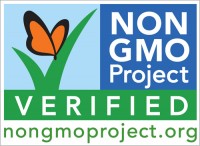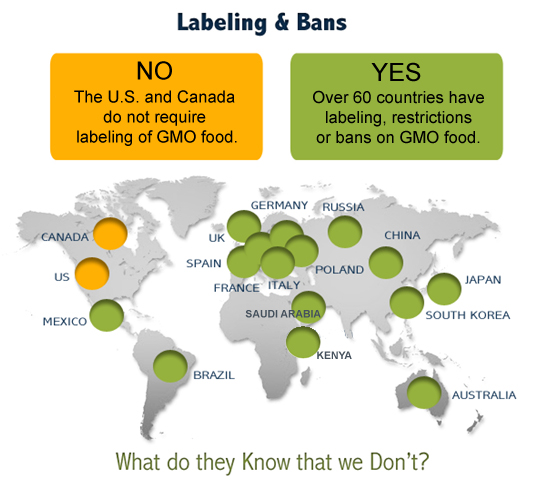
Dangers of GMOs
Genetically Modified Foods, Herbicides and Pesticides and Breast Cancer

Another major hazard to everyone is the increase of Genetically Modified Organisms (GMOs) in our food supply since the 1990s. The genetically modified foods are now in more than 80% of processed foods including baby formula and have been discovered to cause a growing host of health problems. Corn, soy, canola, sugar beets and cottonseed are predominantly genetically modified. There are a multitude of other foods that are currently being modified and are infiltrating your food supply without your knowledge. This is the largest human food experiment ever performed, we are all part of it and it is being done without our consent. The Chinese and Russians are even able to make a choice about what is in their food because it is labeled. Over 60 countries have labeling, restrictions or bans on GMO foods.
Recent European studies in 2012 have been showing tumor formation in laboratory animals fed these genetically altered foods. In 2010 a Canadian study found the genetically engineered food BT Toxin in the blood of women and in their fetal blood supply. Some research is showing that some of the BT Toxin in corn is actually making its own pesticide factory in your own intestines!
The other way of getting the BT Toxin into your blood is by breathing the pollen from fields planted in GMOs. This is why it is so critical to stop the use of GMO seeds and planting and to know what is in your food supply. The GMOs are then contaminating your organic agriculture and crops with pollen drift. The current organic certification process does not require GMO testing. If this continues and the population in the US does not wake up and take action these “Franken Foods” will quietly take over our food supply and contaminate farms everywhere.
Do you wonder if there is a connection to the myriad of new cases of “Leaky gut syndrome”, irritable bowel, gluten intolerance, other GI problems, auto-immune diseases and the rising tide of diabetics and obesity that is now affecting our children? Current statistics show that over 65% of eight grade children are clinically obese.

If this situation was not bad enough, the GMO crops were created to withstand being sprayed with herbicide. This means that the 80% of processed foods that Americans are eating now also contain herbicides and pesticide residue which are estrogen mimickers or estrogen disruptors.
European countries and many Asian countries have banned GMO foods. I encourage you to see the video “Genetic Roulette” as a short remix video. To view this video on our website, click here.
To learn more about this major threat to your health click here to read materials by Oregonians for Farm and Food Rights below and go to Take Action to learn more about what other activist groups are doing.
GMO Myths

This material is brought to you by Oregonians for Farm & Food Rights.
Genetically modified crops are promoted on the basis of a range of far–reaching claims from the biotech industry and its supporters. A new, evidence–based report by U.K. scientists shows these claims are unsubstantiated. Here is a snapshot of their findings.
MYTH #1: Genetic engineering is just an extension of natural breeding.
TRUTH: Genetic engineering is very different from natural breeding and poses special risks. Natural breeding occurs between like life forms-a cat with a cat, not a cat with a dog or a tomato with a fish. GM transfers DNA between unrelated organisms in ways that do not occur naturally.
MYTH #2: GM foods are strictly regulated for safety.
TRUTH: GM food regulation in most countries varies from non-existent (the U.S.) to weak. In the U.S. the FDA overruled its own scientists to form a GM policy, in the 1990s. The policy required no safety testing or labeling.
MYTH #3: GM foods are safe to eat.
TRUTH: GM foods can be toxic or allergenic. Peer-reviewed studies have found serious, harmful effects on the health of livestock and lab animals fed GMOs.
MYTH #4: GM Bt insecticidal crops harm only insects and are harmless to animals and people.
TRUTH: GM Bt insecticidal crops pose hazards to people and animals that ingest them. Findings include toxic effects on the small intestine, liver, kidney, spleen, and pancreas, and disturbances in the digestive and immune systems.
MYTH #5: GM animal feed poses no risks to animal or human health.
TRUTH: GM feed affects the health of animals and may affect the humans who eat their products. Bt toxin protein has been found in the blood of pregnant women and the blood supply to their fetuses.
MYTH #6: GM crops increase yield potential.
TRUTH: GM crops do not increase yield potential-and in many cases decrease it. Dr. Doug Gurian-Sherman: “Traditional breeding …can be solely credited with the intrinsic yield increases in the U.S. and other parts of the world that characterized the agriculture of the 20th century”.
MYTH #7: GM crops decrease pesticide use.
TRUTH: GM crops increase pesticide use. In the first 13 years since their introduction, in 1996, GM crops increased pesticide use by 383 million pounds.
MYTH #8: No-till farming with GM crops is “environmentally friendly”.
TRUTH: Claims of environmental benefits are unsound. GM herbicide-tolerant crops, such as Roundup Ready soy, have increased the use of toxic chemicals and led to glyphosate-resistant superweeds. These superweeds and other pests now require even more chemical controls.
MYTH #9: Roundup (Monsanto’s glyphosate) is a benign, biodegradable herbicide.
TRUTH: Roundup is not biodegradable, and was forced by law to remove that claim from its packaging. Roundup persists in the environment and has toxic effects on wildlife. Roundup (Glyphosate) is toxic, and was detected in 60%-100% of air and rain samples in the U.S. Midwest during crop growing season.
MYTH #10: GM crops can “coexist” with non-GM.
TRUTH: “Coexistence” rapidly results in widespread contamination of non-GM and organic crops. Germany passed a law making GM crop growers liable for economic damages to non-GM farmers resulting from GM contamination. The law has virtually halted the planting of GM crops in that country.
MYTH #11: GM will deliver climate-ready crops.
TRUTH: Conventional breeding outstrips GM in delivering climate-ready crops. Tolerance to extreme weather and resistance to accompanying pests and diseases are complex traits that GM cannot deliver.
MYTH #12: GM reduces energy use.
TRUTH: GM crops are energy-hungry. They depend on large amounts of herbicides which require large amounts of fossil fuels to manufacture. The U.S. food system spends 10 kilocalories of fossil energy for every 1 kilocalorie produced. Two-thirds of that energy goes to produce synthetic fertilizers and on-farm mechanization.
MYTH #13: GM crops are needed to feed the world’s growing population.
TRUTH: GM crops are irrelevant to feeding the world. GM neither delivers higher yields nor produces more with fewer inputs than non-GM crops. Hunger is a problem of distribution, poverty, and loss of crop diversity – which GM crop growth in developing nations has been shown to worsen..
MYTH #14: GM crops are vital to achieving food security.
TRUTH: Agro-ecological farming is the key to food security, according to 400 scientists and experts from 80 countries, a position endorsed by 62 governments worldwide. Their report, the International Assessment of Agricultural Knowledge, Science and Technology, did not endorse GM crops or livestock.
Summarized from “GMO Myths and Truths: An evidence-based examination of the claims made for the safety and efficacy of genetically modified crops,” by Michael Antoniou, PhD; Claire Robinson, MPhil; and John Fagan, PhD; June 2012, published by Earth Open Source, a London based not-for-profit dedicated to assuring the sustainability, security, and safety of the global food system. Download the free 123-page report at www.earthopensource.org.

Currently, the only way to know you are not purchasing food contaminated with GMOs is to not buy anything that contains a likely GMO food, and to buy only processed foods with the “Non-GMO Project Verified seal”.
Genetically modified food, also called frankenfood by critics, is found in most processed food in the US. If you eat food made from corn, canola, soybeans, cottonseed oil, or sugar from beets, you are most likely ingesting GMOs. Livestock animals, including dairy cows, are fed predominantly corn, canola, soy, and alfalfa, which is also genetically engineered.
Currently, a GM Atlantic salmon is up for approval for American tables, as well. Not one of these plant or animal products is required to be labeled in the U.S., even though the public has repeatedly demanded choice. Currently, the only way to know you are not purchasing food contaminated with GMOs is to not buy anything that contains a likely GMO food, and/or to buy only processed foods that have the “Non-GMO Project Verified seal”.
What can we do if we want the right to choose? First, take the time to learn more.
Your rights depend upon it.
Info from the Non-GMO Project website:
http://www.nongmoproject.org/learn-more/
What are GMOs?
GMOs, or “genetically modified organisms,” are plants or animals created through the gene splicing techniques of biotechnology (also called genetic engineering, or GE). This experimental technology merges DNA from different species, creating unstable combinations of plant, animal, bacterial and viral genes that cannot occur in nature or in traditional crossbreeding.
Virtually all commercial GMOs are engineered to withstand direct application of herbicide and/or to produce an insecticide. Despite biotech industry promises, none of the GMO traits currently on the market offer increased yield, drought tolerance, enhanced nutrition, or any other consumer benefit.
Meanwhile, a growing body of evidence connects GMOs with health problems, environmental damage and violation of farmers’ and consumers’ rights.
Are GMOs safe?
Most developed nations do not consider GMOs to be safe. In nearly 50 countries around the world, including Australia, Japan, and all of the countries in the European Union, there are significant restrictions or outright bans on the production and sale of GMOs. In the U.S., the government has approved GMOs based on studies conducted by the same corporations that created them and profit from their sale. Increasingly, Americans are taking matters into their own hands and choosing to opt out of the GMO experiment.
Are GMOs labeled?
Unfortunately, even though polls consistently show that a significant majority of Americans want to know if the food they’re purchasing contains GMOs, the powerful biotech lobby has succeeded in keeping this information from the public. In the absence of mandatory labeling, the Non-GMO Project was created to give consumers the informed choice they deserve.
Where does the Non-GMO Project come in?
The Non-GMO Project is a non-profit organization with a mission of protecting the non-GMO food supply and giving consumers an informed choice. We offer North America’s ONLY third party verification for products produced according to rigorous best practices for GMO avoidance (for more info, click here). Our strategy is to empower consumers to make change through the marketplace. If people stop buying GMOs, companies will stop using them and farmers will stop growing them.
Do Americans want non-GMO foods and supplements?
Polls consistently show that a significant majority of North Americans would like to be able to tell if the food they’re purchasing contains GMOs (a 2008 CBS News Poll found that 87% of consumers wanted GMOs labeled). And, according to a recent CBS/New York Times poll, 53% of consumers said they would not buy food that has been genetically modified. The Non-GMO Project’s seal for verified products will, for the first time, give the public an opportunity to make an informed choice when it comes to GMOs.
How common are GMOs?
In the U.S., GMOs are in as much as 80% of conventional processed food. Click here for a current list of GMO risk crops.
Why does the Non-GMO Project verify products that have a low risk of containing GMOs?
Some ingredients that seem low-risk may have less-visible high-risk ingredients. Take, for example, dried fruit. Raisins and similar fruit are sometimes packed with a small quantity of oil to keep them moist. This oil, when used, is sometimes high-GMO-risk. As such, it is critical that we do take the time to look carefully at ingredient spec sheets during the verification process, to ensure that risks like this are effectively mitigated, even in apparently low-risk products.
Contamination incidents have occurred with seemingly “low-risk” products (rice, starling corn, flax). Non-GMO Project Verification supports manufacturers in being able to quickly and proactively respond to unexpected contamination issues.
Verifying only high-risk products puts a heavy burden on consumers to know what products are at risk of containing GMOs. Many people, even in the world of Natural Foods, don’t know what a GMO is, let alone which crops and processed ingredients are high-risk. As such, labeling only products that contain high-risk ingredients could give an unfair competitive advantage to products that contain ingredients containing corn, soy, etc. Taking the cereal aisle for our example, if we verified only high-risk products, a shopper might see the seal on a box of verified corn flakes, but not on the wheat-based cereal box next to them, produced with the same high standards by the same company. This could leave them thinking the corn flakes were non-GMO, but that they should avoid the wheat product, even though there’s no GMO wheat on the market. Given the lack of understanding of the issue, this presents some serious issues.
Through verifying low-risk products, the Non-GMO Project’s work builds consumer interest and industry investment in Non-GMO, even for crops that aren’t genetically engineered yet. Biotech is constantly working to patent and commercialize new organisms (salmon, apples, etc.), and the more companies that have committed to Non-GMO production, the more resistance these new developments will see prior to release.
What are the impacts of GMOs on the environment?
Over 80% of all GMOs grown worldwide are engineered for herbicide tolerance. As a result, use of toxic herbicides like Roundup has increased 15 times since GMOs were introduced. GMO crops are also responsible for the emergence of “super weeds” and “super bugs:’ which can only be killed with ever more toxic poisons like 2,4-D (a major ingredient in Agent Orange). GMOs are a direct extension of chemical agriculture, and are developed and sold by the world’s biggest chemical companies. The long-term impacts of GMOs are unknown, and once released into the environment these novel organisms cannot be recalled.
How do GMOs affect farmers?
Because GMOs are novel life forms, biotechnology companies have been able to obtain patents with which to restrict their use. As a result, the companies that make GMOs now have the power to sue farmers whose fields are contaminated with GMOs, even when it is the result of inevitable drift from neighboring fields. GMOs therefore pose a serious threat to farmer sovereignty and to the national food security of any country where they are grown, including the United States.
How can I avoid GMOs?
Choose food and products that are Non-GMO Project Verified! Click here to see a complete list.





